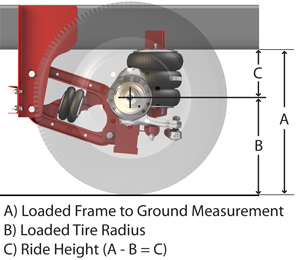What is the correct ride height of a loaded truck when weighing with onboard scales?
The correct ride height of a loaded truck can vary depending on several factors, including the specific truck model, suspension design, manufacturer’s recommendations, and legal regulations in the jurisdiction where the truck is operated. Here are some general considerations regarding ride height:
- Manufacturer’s Recommendations: The manufacturer of the truck typically provides guidelines and specifications regarding the recommended ride height for loaded conditions. These recommendations take into account the specific suspension design, axle configuration, and intended use of the truck. It is essential to consult the manufacturer’s documentation, such as the owner’s manual or technical specifications, to determine the correct ride height for a loaded truck.

- Level and Balanced: The goal of setting the ride height for a loaded truck is to achieve a level and balanced position. The truck should neither appear excessively squatting at the rear (indicating a rearward weight bias) nor have the front end significantly higher than the rear (indicating a forward weight bias). A level ride height helps ensure proper weight distribution across the axles and promotes stability and optimal handling.
- Compliance with Legal Regulations: Legal regulations regarding ride height and axle weight limits vary by jurisdiction. It is crucial to comply with the applicable regulations to ensure road safety and avoid potential penalties or legal issues. These regulations may dictate specific maximum and minimum ride heights or axle weight limits that must be adhered to when the truck is loaded.
- Suspension System Characteristics: The suspension system of the truck, including the type of suspension (such as leaf springs, air suspension, or coil springs), will influence the ideal ride height. Different suspension systems have varying characteristics and tolerances for ride height adjustments. The manufacturer’s guidelines will provide specific instructions on adjusting the ride height within the capabilities of the suspension system.
- Consider Load Distribution: When setting the ride height for a loaded truck, it is essential to consider the distribution of the load. The weight should be distributed evenly across the axles to ensure balanced handling and prevent excessive strain on specific components. Proper load distribution helps maintain the correct ride height and promotes safe and efficient operation.
Given the various factors involved, it is recommended to refer to the manufacturer’s recommendations and consult with professionals, such as authorized dealers or service centers, to determine the correct ride height for a specific loaded truck. They can provide specific guidance based on the truck’s make, model, suspension system, and intended use, ensuring that the ride height is set appropriately for optimal performance, safety, and compliance with regulations.

